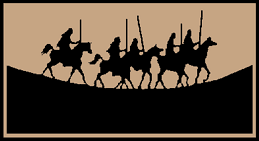 |
||||||||
Al Khamsa published its first directory in 1976, cataloguing Arab horses registered in the U.S. and Canada "which can reasonably be said to descend entirely from horses bred in the Arabian desert by Bedouin tribes." No root stock is listed in this book; however, the names of many desertbred horses are included in a concise essay portraying the overarching concept of the Al Khamsa preservation effort through the history of the horse-breeding nomads of the Arabian peninsula. Introductory comments acknowledge the difficulties in tracing living horses to their desertbred roots: "As long as secondary sources are relied upon it would seem that real scholarship on these matters is impossible and that a thorough re-appraisal of the primary source material of these pedigrees is in order." The second Al Khamsa directory, Al Khamsa Arabians, was published in 1983. Two major cataloguing systems are introduced: the Foundation Horse, and the Ancestral Element. Presented in this volume are 139 Foundation Horses and in addition, 22 Ancestral Elements to categorize the horses, because "it would be impractical to list all of the Foundation Horses found in the pedigree of each living horse in order to discuss its pedigree makeupů" Al Khamsa Arabians II was published in 1993, shortly after the Heirloom Research Group had discovered a coherent system for identifying the taproot horses of the earliest era of modern asil Egyptian Arab horse breeding. While our initial vision was provided by the list of Root Mares and Root Stallions presented in the first published Egyptian government studbook, History of the Royal Agricultural Society's Stud of Authentic Arabian Horses (Cairo, 1948), the concept of Heirloom was given unexpected support by AKA II. All living Heirloom horses appearing in the third Al Khamsa directory are categorized as Egypt I and Blunt ancestral elements; only Heirloom horses carry this designation exclusively. Our efforts were both confirmed and encouraged by the fact that our independent line of study into the history of early Egyptian breeding had reached a conclusion similar to Al Khamsa's research. For further information about Al Khamsa, Inc., to order its publications, access its online pedigree roster, and learn about its activities, visit www.alkhamsa.org. | |||||||||
HOME | BACKGROUND | HISTORY | LIBRARY | GLOSSARY | THE HERD

HERDBOOK | AL KHAMSA | CONTACT
Website designed by HYPERSPHERE

©2005 Elizabeth & Cheryl Fippen
All rights reserved.
HERDBOOK | AL KHAMSA | CONTACT
Website designed by HYPERSPHERE
©2005 Elizabeth & Cheryl Fippen
All rights reserved.

